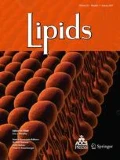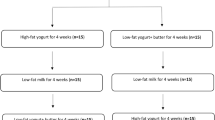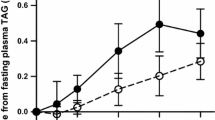Abstract
Chemical and enzymatic interesterification are used to create spreadable fats. However, a comparison between the two processes in terms of their acute metabolic effects has not yet been investigated. A randomised crossover study in obese (plasma TAG > 1.69 mmol/L, and BMI > 30 (BMI = kg/m2) or waist circumference > 102 cm, n = 11, age = 59.3 ± 1.8 years) and non-obese (plasma triacylglycerol (TAG) < 1.69 mmol/L, and BMI < 30 or waist circumference < 102 cm, n = 10, age = 55.8 ± 2.2 years) men was undertaken to compare the effects of chemical versus enzymatic interesterification on postprandial risk factors for type 2 diabetes (T2D) and cardiovascular disease (CVD). TAG, cholesterol, glucose, insulin and free fatty acid concentrations were measured for 6 h following consumption of 1 g fat/kg body mass of non-interesterified (NIE), chemically interesterified (CIE), enzymatically interesterified (EIE) stearic acid-rich fat spread or no fat, each with 50 g available carbohydrate from white bread. Interesterification did not affect postprandial glucose, insulin, free fatty acids or cholesterol (P > 0.05). Following ingestion of NIE, increases in serum oleic acid were observed, whereas both oleic and stearic acids were increased with CIE and EIE (P < 0.05). While postprandial TAG concentrations in non-obese subjects were not affected by fat treatment (P > 0.05), obese subjects had an 85% increase in TAGs with CIE versus NIE (P < 0.05). The differences in TAG response between non-obese and obese subjects suggest that interesterification may affect healthy individuals differently compared to those already at risk for T2D and/or CVD.



Similar content being viewed by others
Abbreviations
- AUC:
-
Area under the curve
- BMI:
-
Body mass index
- CIE:
-
Chemically interesterified test fat
- CVD:
-
Cardiovascular disease
- DAG:
-
Diacylglycerol
- EIE:
-
Enzymatically interesterified test fat
- GC:
-
Gas chromatography
- HOMA-IR:
-
Homeostasis model of insulin resistance
- HPLC:
-
High performance liquid chromatography
- IE:
-
Interesterification
- NIE:
-
Non-interesterified test fat
- SEM:
-
Standard error of the mean
- SSS:
-
Tristearin
- T2D:
-
Type 2 diabetes
- TAG:
-
Triacylglycerol
References
List GR, Pelloso T, Orthoefer F, Chrysam M, Mounts TL (1995) Preparation and properties of zero trans soybean oil margarines. J Am Oil Chem Soc 72:383–384
Upritcharda JE, Zeelenberga MJ, Huizingaa H, Verschurena PM, Trautweina EA (2005) Modern fat technology: what is the potential for heart health? Proc Nutr Soc 64:379–386
Sreenivasan B (1978) Interesterification of fats. J Am Oil Chem Soc 55:796–805
Grundy S (1994) Influence of stearic acid on cholesterol metabolism relative to other long-chain fatty acids. Am J Clin Nutr 60:986S–990S
Sundram K, Karupaiah T, and Hayes K (2007) Stearic acid-rich interesterified fat and trans-rich fat raise the LDL/HDL ratio and plasma glucose relative to palm olein in humans. Nutr Metab (serial online) 4: July 5 2007. URL: http://www.nutritionandmetabolism.com/content/4/1/3
Mattson FH, Volpenhein RA (1964) The digestion and absorption of triglycerides. J Biol Chem 239:2772–2777
Renaud SC, Ruf JC, Petithory D (1995) The positional distribution of fatty acids in palm oil and lard influences their biologic effects in rats. J Nutr 125:229–237
Mortimer B, Kenrick MA, Holthouse DJ, Stick RV, Redgrave TG (1992) Plasma clearance of model lipoproteins containing saturated and polyunsaturated monoacylglycerols injected intravenously in the rat. Biochem Biophys Acta 1127:67–73
De Fouw NJ, Kivits GAA, Quinlan PT, van Nielen WG, Wim GL (1994) Absorption of isomeric, palmitic acid-containing triacylglycerols resembling human milk fat in the adult rat. Lipids 29:765–770
Redgrave TG, Kodali DR, Small DM (1998) The effect of triacyl-sn-glycerol structure on the metabolism of chylomicrons and triacylglycerol-rich emulsions in the rat. J Biol Chem 263:5118–5123
Mortimer BC, Simmonds WJ, Joll CA, Stick RV, Redgrave TG (1988) Regulation of the metabolism of lipid emulsion model lipoproteins by a saturated acyl chain at the 2-position of triacylglycerol. J Lipid Res 29:713–720
Aoe S, Yamamura J, Matsuyama H, Hase M, Shiota M, Miura S (1997) The positional distribution of dioleoyl–palmitoyl glycerol influences lymph chylomicron transport, composition and size in rats. J Nutr 127:1269–1273
Brink EJ, Haddeman E (1995) Positional distribution of stearic acid and oleic acid in a triacylglycerol and dietary calcium concentration determines the apparent absorption of these fatty acids in rats. J Nutr 125:2379–2387
Mattson FH, Nolen GA, Webb MR (1979) The absorbability by rats of various triglycerides of stearic and oleic acid and the effect of dietary calcium and magnesium. J Nutr 109:1682
Zilversmit D (1979) Atherogenesis: a postprandial phenomenon. Circulation 60:473–485
Karpe F (1997) Postprandial lipid metabolism in relation to coronary heart disease. Proc Nutr Soc 56:671–678
Ceriello A, Davidson J, Hanefeld M, Leiterd M, Monniere L, Owens D, Tajima N, Tuomilehto J (2006) Postprandial hyperglycaemia and cardiovascular complications of diabetes: an update. Nutr Metab Cardiovasc Dis 16:453–456
Expert Panel on Detection, Evaluation, and Treatment of High Blood Cholesterol in Adults (2001) Executive summary of the third report of the national cholesterol education program (NCEP) expert panel on detection, evaluation, and treatment of high blood cholesterol in adults (adult treatment panel III). JAMA 285:2486–2497
Kolovou GD, Anagnostopoulou KK, Pavlides AN, Salpea K, Iraklianou A, Tsarpalis K, Damaskos DS, Manolis A, Cokkinos DV (2005) Postprandial lipemia in men with metabolic syndrome, hypertensives and healthy subjects. Lipids Health Dis 4:21–29
Blackburn P, Lamarche B, Couillard C, Pascot A, Bergeroc N, Prud’homme D, Tremblay A, Bergeron J, Lemieux I, Despres JP (2003) Postprandial hyperlipidemia: another correlate of the “hypertriglyceridemic waist” phenotype in men. Atherosclerosis 171:327–336
Matthews DR (1985) Homeostasis model assessment: insulin resistance and β-cell function from fasting plasma glucose and insulin concentrations in man. Diabetologia 28:412–419
Friedewald WT, Levy RI, Fredrickson DS (1972) Estimation of the concentration of low-density lipoprotein cholesterol in plasma, without use of the preparative ultracentrifuge. Clin Chem 18:499–502
National Institute of Health (1998) Clinical guidelines on the identification, evaluation and treatment of overweight and obesity in adults. Obes Res 6:51S–209S
Bergstedt SE, Hayashi H, Kritchevsky D, Tso P (1990) Comparison of absorption of glycerol tristearate and glycerol trioleate by rat small intestine. Am J Physiol Gastrointest Liver Physiol 9:G386–G393
Livesey G (2000) The absorption of stearic acid from triacylglycerols: an inquiry and analysis. Nutr Res Rev 13:185–214
Summers LKM, Fielding BA, Herd SL, Ilic V, Clark ML, Quinlan PT, Frayn KN (1999) Use of structured triacylglycerols containing predominantly stearic and oleic acids to probe early events in metabolic processing of dietary fat. J Lipid Res 40:1890–1898
Yli-Jokipii KM, Schwab US, Tahvonen RL, Kurvinen J, Mykkanen HM, Kallio HPT (2002) Triacylglycerol molecular weight and to a lesser extent, fatty acid positional distribution, affect chylomicron triacylglycerol composition in women. J Nutr 132:924–929
Summers LKM, Fielding BA, Ilic V, Quinlan PT, Frayn KN (1998) The effect of triacylglycerol-fatty acid positional distribution on postprandial metabolism in subcutaneous adipose tissue. Br J Nutr 79:141–147
Yli-Jokipii K, Schwab US, Tahvonen RL, Kurvinen J, Mykkanen HM, Kallio HPT (2003) Chylomicron and VLDL TAG structures and postprandial lipid response induced by lard and modified lard. Lipids 38:693–703
Berry SE, Miller GJ, Sanders TA (2007) The solid fat content of stearic acid-rich fats determines their postprandial effects. Am J Clin Nutr 85:1486–1494
Taguchi H, Watanabe H, Onizawa K, Nagao T, Gotoh N, Yasukawa T, Tsushima R, Shimasaki H, Itakura H (2000) Double-blind controlled study on the effects of dietary diacylglycerol on postprandial serum and chylomicron triacylglycerol responses in healthy humans. J Am Coll Nutr 19:789–796
Zampelas A, Williams CM, Morgan LM, Wright J, Quinlan PT (1994) The effect of triacylglycerol fatty acid positional distribution on postprandial plasma metabolite and hormone responses in normal adult men. Br J Nutr 71:401–410
Cohen JC, Berger GM (1990) Effects of glucose ingestion on postprandial lipemia and triglyceride clearance in humans. J Lipid Res 31:597–602
Collier G, O’Dea K (1983) The effect of coingestion of fat on the glucose, insulin, and gastric inhibitory polypeptide responses to carbohydrate and protein. Am J Clin Nutr 37:941–944
Patsch JR, Miesenbock G, Hopferwieser T, Muhlberger B, Knapp E, Dunn JK, Gotto AM Jr, Patsch W (1992) Relation of triglyceride metabolism and coronary artery disease. Studies in the postprandial state. Arterioscler Thromb Vasc Biol 12:1336–1345
Leiter LA, Ceriello A, Davidson JA, Hanefeld M, Monnier L, Owens DR, Tajima N, Tuomilehto J (2005) Postprandial glucose regulation: new data and new implications. Clin Ther 27:S42–S56
Acknowledgments
We thank the study participants for their time and commitment. We thank Mehrnoosh Kashani and Ricky Lam for their technical assistance and the Human Nutraceutical Research Unit at the University of Guelph and the Guelph Food Technology Centre for the use of their facilities. We also thank Bunge Canada for supplying the fully hydrogenated canola stearin and the Ontario Ministry of Agriculture, Food and Rural Affairs for funding.
Author information
Authors and Affiliations
Corresponding author
About this article
Cite this article
Robinson, D.M., Martin, N.C., Robinson, L.E. et al. Influence of Interesterification of a Stearic Acid-Rich Spreadable Fat on Acute Metabolic Risk Factors. Lipids 44, 17–26 (2009). https://doi.org/10.1007/s11745-008-3253-7
Received:
Accepted:
Published:
Issue Date:
DOI: https://doi.org/10.1007/s11745-008-3253-7




